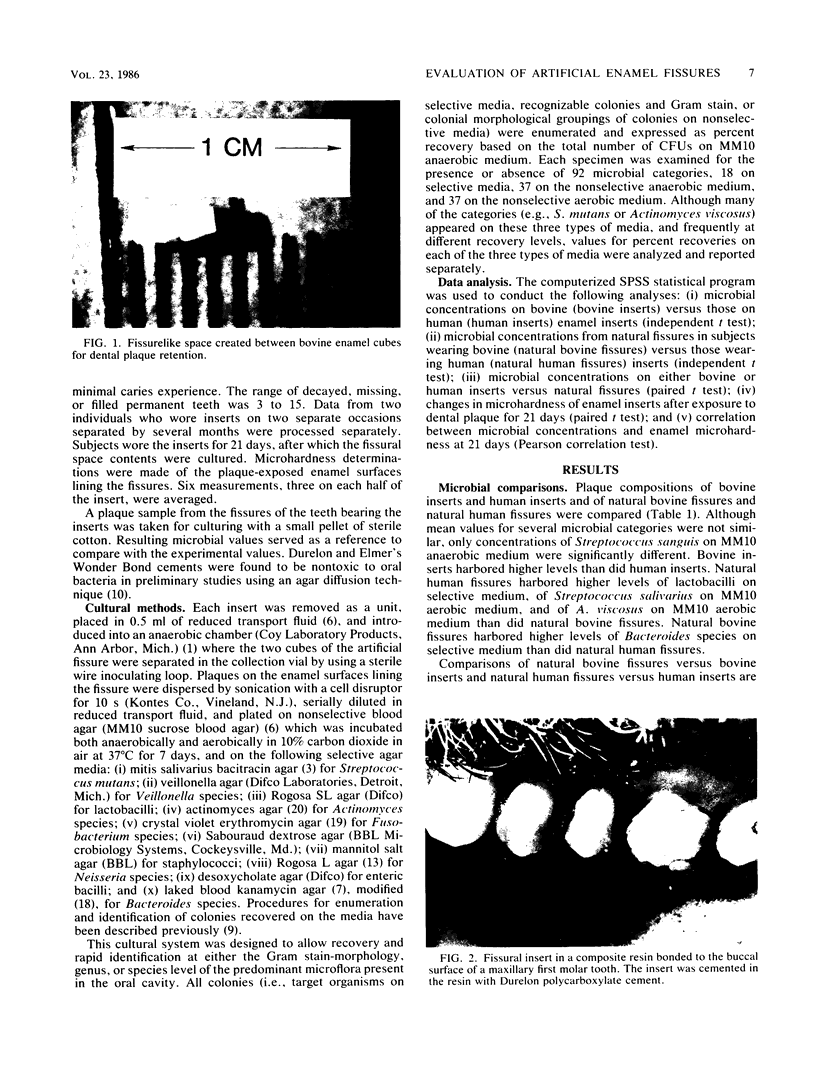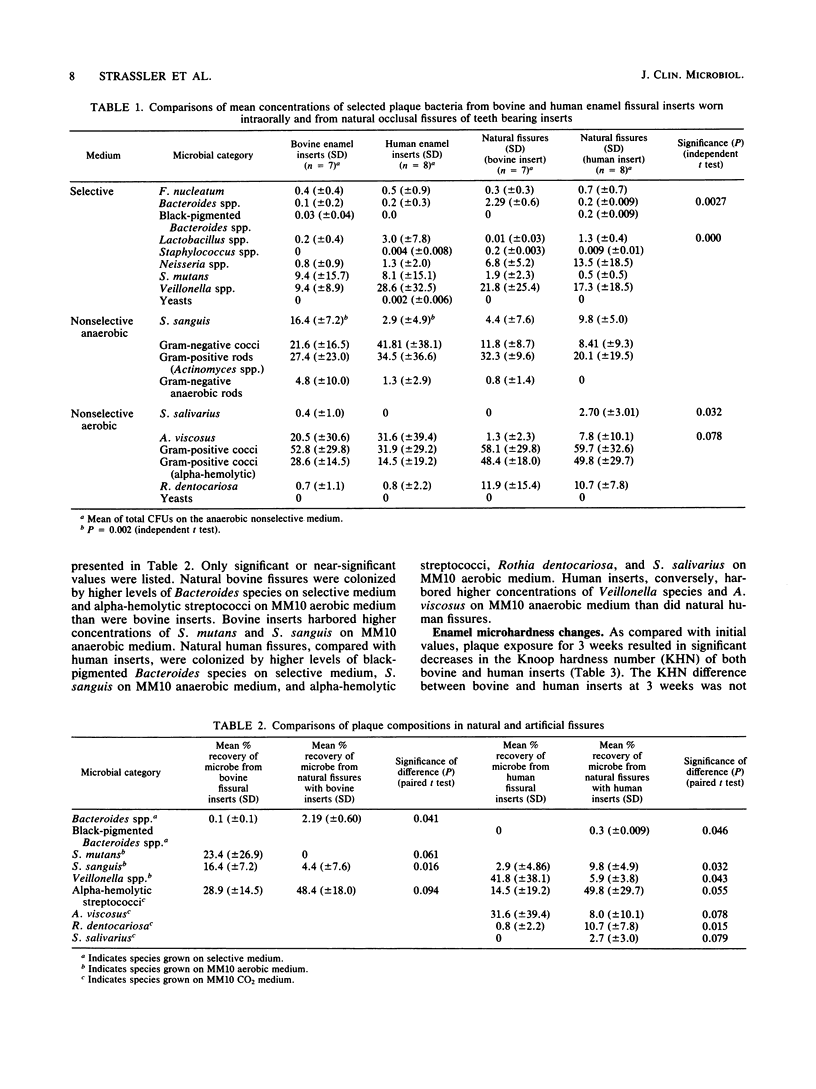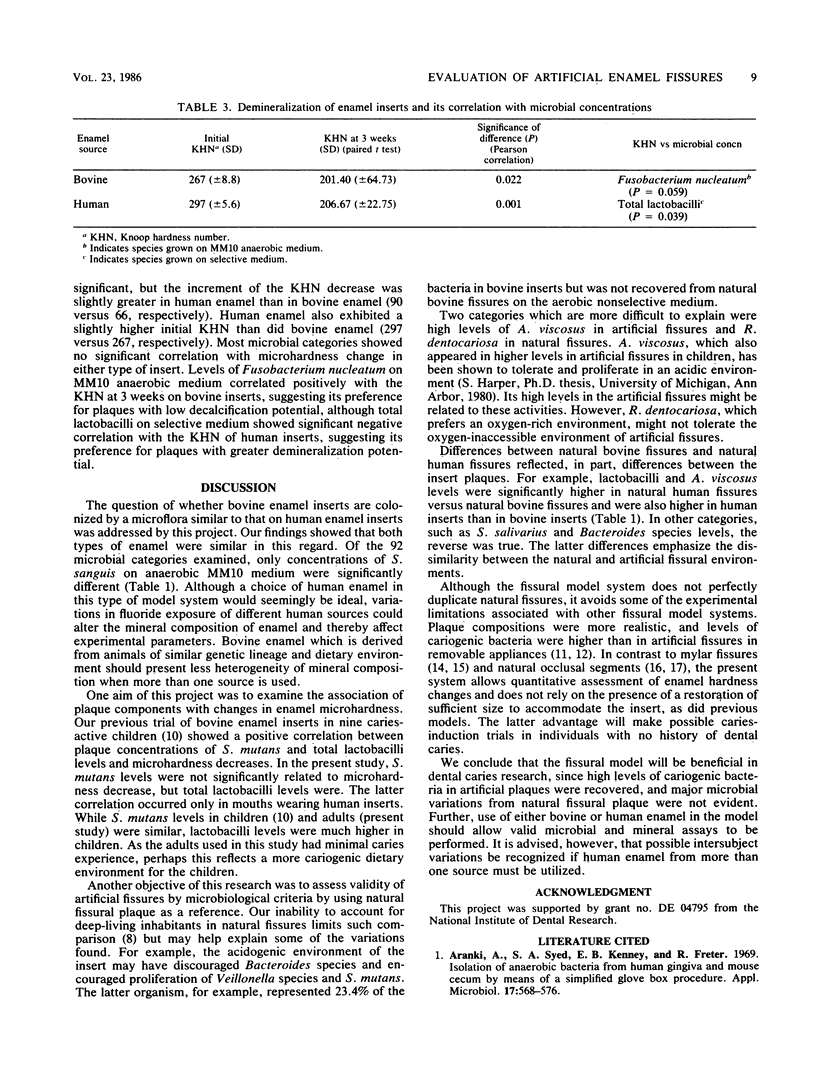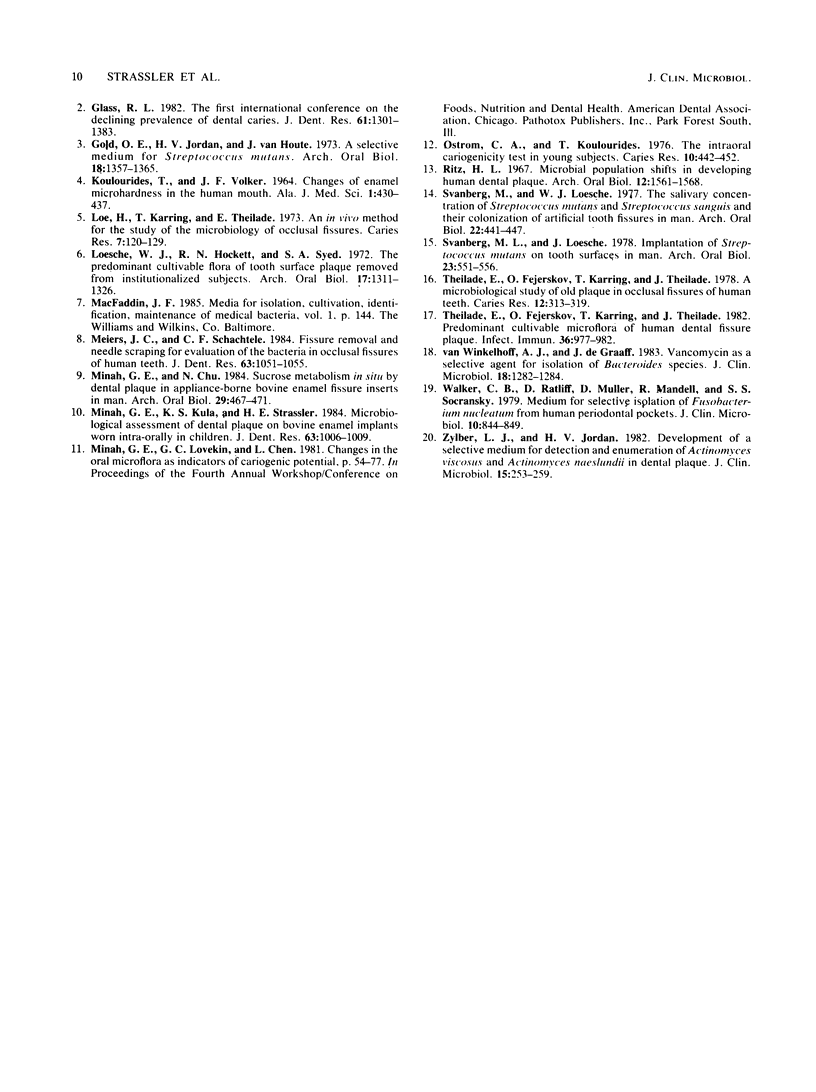Abstract
Devices simulating occlusal fissures were constructed from dental enamel and bonded to human maxillary molar teeth for 3 weeks. Facilitation of in vivo caries research in humans is the long-range goal for this model system. In the present investigation, microbial compositions of plaque in the fissural space of the model and natural fissural plaque from teeth bearing the devices were compared. Plaque from models constructed from either bovine or human enamel was also compared. In addition, microhardness of the enamel surfaces was examined before and after oral exposure. Plaque in both bovine and human enamel models differed significantly from natural fissural plaque in several microbial categories. Differences appeared to be related to the increased accessibility of the deep fissural contents of the models. For example, levels of the aciduric Streptococcus mutans and Veillonella species were higher in the models, although levels of a salivary inhabitant, Streptococcus salivarius, were lower. Plaque in bovine and human enamel models was similar, and both models showed significant decreases in enamel microhardness after oral exposure for 3 weeks. The model system should be useful in caries research in that carieslike activity was simulated within a relatively short period of time, and the fissural space became colonized by high levels of cariogenic bacteria.
Full text
PDF




Images in this article
Selected References
These references are in PubMed. This may not be the complete list of references from this article.
- Arank A., Syed S. A., Kenney E. B., Freter R. Isolation of anaerobic bacteria from human gingiva and mouse cecum by means of a simplified glove box procedure. Appl Microbiol. 1969 Apr;17(4):568–576. doi: 10.1128/am.17.4.568-576.1969. [DOI] [PMC free article] [PubMed] [Google Scholar]
- Gold O. G., Jordan H. V., Van Houte J. A selective medium for Streptococcus mutans. Arch Oral Biol. 1973 Nov;18(11):1357–1364. doi: 10.1016/0003-9969(73)90109-x. [DOI] [PubMed] [Google Scholar]
- KOULOURIDES T., VOLKER J. F. CHANGES OF ENAMEL MICROHARDNESS IN THE HUMAN MOUTH. Ala J Med Sci. 1964 Oct;1:435–437. [PubMed] [Google Scholar]
- Loesche W. J., Hockett R. N., Syed S. A. The predominant cultivable flora of tooth surface plaque removed from institutionalized subjects. Arch Oral Biol. 1972 Sep;17(9):1311–1325. doi: 10.1016/0003-9969(72)90164-1. [DOI] [PubMed] [Google Scholar]
- Löe H., Karring T., Theilade E. An in vivo method for the study of the microbiology of occlusal fissures. Caries Res. 1973;7(2):120–129. doi: 10.1159/000259836. [DOI] [PubMed] [Google Scholar]
- Meiers J. C., Schachtele C. F. Fissure removal and needle scraping for evaluation of the bacteria in occlusal fissures of human teeth. J Dent Res. 1984 Aug;63(8):1051–1055. doi: 10.1177/00220345840630080801. [DOI] [PubMed] [Google Scholar]
- Minah G. E., Chu N. Sucrose metabolism in situ by dental plaque in appliance-borne bovine enamel tooth fissure inserts in man. Arch Oral Biol. 1984;29(6):467–471. doi: 10.1016/0003-9969(84)90028-1. [DOI] [PubMed] [Google Scholar]
- Minah G. E., Kula K. S., Strassler H. E. Microbiological assessment of dental plaque on bovine enamel implants worn intra-orally in children. J Dent Res. 1984 Jul;63(7):1006–1009. doi: 10.1177/00220345840630070201. [DOI] [PubMed] [Google Scholar]
- Ostrom C. A., Koulourides T. The intraoral cariogenicity test in young subjects. Caries Res. 1976;10(6):442–452. doi: 10.1159/000260236. [DOI] [PubMed] [Google Scholar]
- Ritz H. L. Microbial population shifts in developing human dental plaque. Arch Oral Biol. 1967 Dec;12(12):1561–1568. doi: 10.1016/0003-9969(67)90190-2. [DOI] [PubMed] [Google Scholar]
- Svanberg M. L., Loesche W. J. Implantation of Streptococcus mutans on tooth surfaces in man. Arch Oral Biol. 1978;23(7):551–556. doi: 10.1016/0003-9969(78)90269-8. [DOI] [PubMed] [Google Scholar]
- Theilade E., Fejerskov O., Karring T., Theilade J. A microbiological study of old plaque in occlusal fissures of human teeth. Caries Res. 1978;12(6):313–319. doi: 10.1159/000260350. [DOI] [PubMed] [Google Scholar]
- Theilade E., Fejerskov O., Karring T., Theilade J. Predominant cultivable microflora of human dental fissure plaque. Infect Immun. 1982 Jun;36(3):977–982. doi: 10.1128/iai.36.3.977-982.1982. [DOI] [PMC free article] [PubMed] [Google Scholar]
- Walker C. B., Ratliff D., Muller D., Mandell R., Socransky S. S. Medium for selective isolation of Fusobacterium nucleatum from human periodontal pockets. J Clin Microbiol. 1979 Dec;10(6):844–849. doi: 10.1128/jcm.10.6.844-849.1979. [DOI] [PMC free article] [PubMed] [Google Scholar]
- Zylber L. J., Jordan H. V. Development of a selective medium for detection and enumeration of Actinomyces viscosus and Actinomyces naeslundii in dental plaque. J Clin Microbiol. 1982 Feb;15(2):253–259. doi: 10.1128/jcm.15.2.253-259.1982. [DOI] [PMC free article] [PubMed] [Google Scholar]
- van Winkelhoff A. J., de Graaff J. Vancomycin as a selective agent for isolation of Bacteroides species. J Clin Microbiol. 1983 Nov;18(5):1282–1284. doi: 10.1128/jcm.18.5.1282-1284.1983. [DOI] [PMC free article] [PubMed] [Google Scholar]




